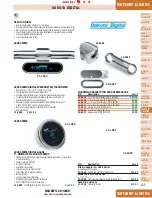
IEPE-Link
™
-LXRS
®
Wireless Sensor Node
User Manual
Specifications
59
9.4
Radio Specifications
The IEPE-Link
™
-LXRS
®
Wireless Sensor Node employs a 2.4GHz IEEE 802.15.4 compliant
radio transceiver for wireless communication. The radio is a direct-sequence spread spectrum
radio and can be configured to operate on 14 separate frequencies ranging from 2.405 GHz to
2.480GHz. Following the 802.15.4 standard, these frequencies are aliased as channel 11
through channel 24. For all newly manufactured nodes, the default setting is equivalent to
2.425GHz (channel 15).
For standard models, radiated transmit power is programmable from 0dBm (1mW) to 16dBm
(39mW). For European models transmit power is limited to 10dBm (10mW).
The radio complies with ETSI EN 300 328, EN 300 440 Class 2, FCC CFR-47 Part 15 and
ARIB STD- T66. The radio is license- free worldwide. Using antennas and transmission
equipment other than what is provided with the node may void FCC compliance.
NOTE
l
The gateway can automatically manage nodes operating on different
frequencies by using the Node Discovery feature in Node Commander
®
. In
this routine, the gateway listens for node broadcasts on the frequency
channel it is set to. If the node is in normal boot up mode, it will provide the
broadcast when it is initially powered on and broadcast on all channels. As
long as the node is powered on after activating the Node Discovery feature,
the gateway will link to it and remember the channel setting for future node
queries.
l
Manually setting the node and gateway frequency channels to match is
required in some applications. For example, when sending broadcast
messages from the gateway to multiple nodes (including the synchronized
sampling beacon), all nodes must be on the same channel as the gateway to
receive the broadcast. Assigning channels is also a good idea when multiple
gateways are attached to one host computer, or when other wireless
equipment is nearby and frequency or transmission interference may occur.








































